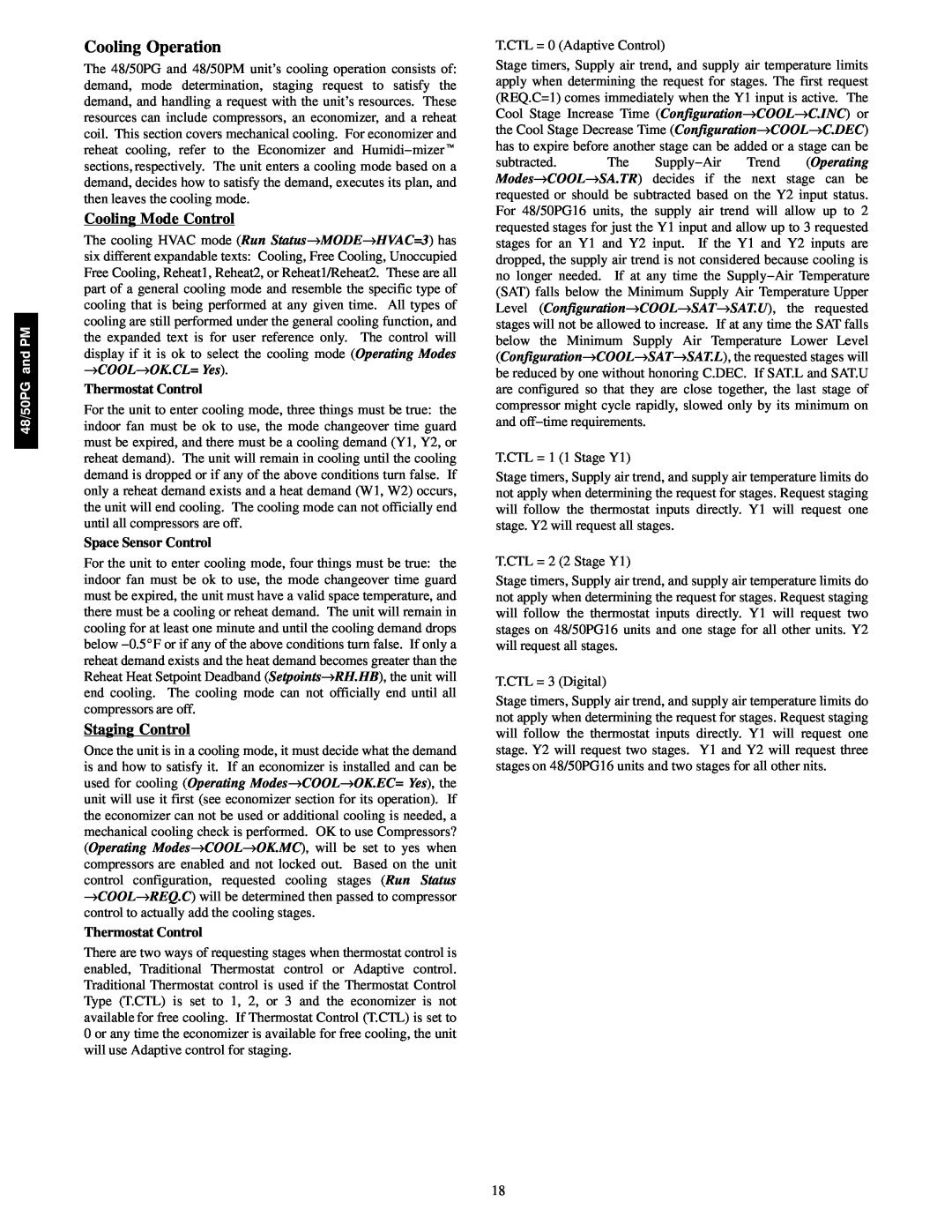48/50PG and PM
Cooling Operation
The 48/50PG and 48/50PM unit’s cooling operation consists of: demand, mode determination, staging request to satisfy the demand, and handling a request with the unit’s resources. These resources can include compressors, an economizer, and a reheat coil. This section covers mechanical cooling. For economizer and reheat cooling, refer to the Economizer and Humidi−mizert sections, respectively. The unit enters a cooling mode based on a demand, decides how to satisfy the demand, executes its plan, and then leaves the cooling mode.
Cooling Mode Control
The cooling HVAC mode (Run Status→MODE→HVAC=3) has six different expandable texts: Cooling, Free Cooling, Unoccupied Free Cooling, Reheat1, Reheat2, or Reheat1/Reheat2. These are all part of a general cooling mode and resemble the specific type of cooling that is being performed at any given time. All types of cooling are still performed under the general cooling function, and the expanded text is for user reference only. The control will display if it is ok to select the cooling mode (Operating Modes →COOL→OK.CL= Yes).
Thermostat Control
For the unit to enter cooling mode, three things must be true: the indoor fan must be ok to use, the mode changeover time guard must be expired, and there must be a cooling demand (Y1, Y2, or reheat demand). The unit will remain in cooling until the cooling demand is dropped or if any of the above conditions turn false. If only a reheat demand exists and a heat demand (W1, W2) occurs, the unit will end cooling. The cooling mode can not officially end until all compressors are off.
Space Sensor Control
For the unit to enter cooling mode, four things must be true: the indoor fan must be ok to use, the mode changeover time guard must be expired, the unit must have a valid space temperature, and there must be a cooling or reheat demand. The unit will remain in cooling for at least one minute and until the cooling demand drops below −0.5_F or if any of the above conditions turn false. If only a reheat demand exists and the heat demand becomes greater than the Reheat Heat Setpoint Deadband (Setpoints→RH.HB), the unit will end cooling. The cooling mode can not officially end until all compressors are off.
Staging Control
Once the unit is in a cooling mode, it must decide what the demand is and how to satisfy it. If an economizer is installed and can be used for cooling (Operating Modes→COOL→OK.EC= Yes), the unit will use it first (see economizer section for its operation). If the economizer can not be used or additional cooling is needed, a mechanical cooling check is performed. OK to use Compressors? (Operating Modes→COOL→OK.MC), will be set to yes when compressors are enabled and not locked out. Based on the unit control configuration, requested cooling stages (Run Status →COOL→REQ.C) will be determined then passed to compressor control to actually add the cooling stages.
Thermostat Control
There are two ways of requesting stages when thermostat control is enabled, Traditional Thermostat control or Adaptive control. Traditional Thermostat control is used if the Thermostat Control Type (T.CTL) is set to 1, 2, or 3 and the economizer is not available for free cooling. If Thermostat Control (T.CTL) is set to 0 or any time the economizer is available for free cooling, the unit will use Adaptive control for staging.
T.CTL = 0 (Adaptive Control)
Stage timers, Supply air trend, and supply air temperature limits apply when determining the request for stages. The first request (REQ.C=1) comes immediately when the Y1 input is active. The Cool Stage Increase Time (Configuration→COOL→C.INC) or the Cool Stage Decrease Time (Configuration→COOL→C.DEC) has to expire before another stage can be added or a stage can be
subtracted. The Supply−Air Trend (Operating Modes→COOL→SA.TR) decides if the next stage can be requested or should be subtracted based on the Y2 input status. For 48/50PG16 units, the supply air trend will allow up to 2 requested stages for just the Y1 input and allow up to 3 requested stages for an Y1 and Y2 input. If the Y1 and Y2 inputs are dropped, the supply air trend is not considered because cooling is no longer needed. If at any time the Supply−Air Temperature (SAT) falls below the Minimum Supply Air Temperature Upper Level (Configuration→COOL→SAT→SAT.U), the requested stages will not be allowed to increase. If at any time the SAT falls below the Minimum Supply Air Temperature Lower Level (Configuration→COOL→SAT→SAT.L), the requested stages will be reduced by one without honoring C.DEC. If SAT.L and SAT.U are configured so that they are close together, the last stage of compressor might cycle rapidly, slowed only by its minimum on and off−time requirements.
T.CTL = 1 (1 Stage Y1)
Stage timers, Supply air trend, and supply air temperature limits do not apply when determining the request for stages. Request staging will follow the thermostat inputs directly. Y1 will request one stage. Y2 will request all stages.
T.CTL = 2 (2 Stage Y1)
Stage timers, Supply air trend, and supply air temperature limits do not apply when determining the request for stages. Request staging will follow the thermostat inputs directly. Y1 will request two stages on 48/50PG16 units and one stage for all other units. Y2 will request all stages.
T.CTL = 3 (Digital)
Stage timers, Supply air trend, and supply air temperature limits do not apply when determining the request for stages. Request staging will follow the thermostat inputs directly. Y1 will request one stage. Y2 will request two stages. Y1 and Y2 will request three stages on 48/50PG16 units and two stages for all other nits.
18
